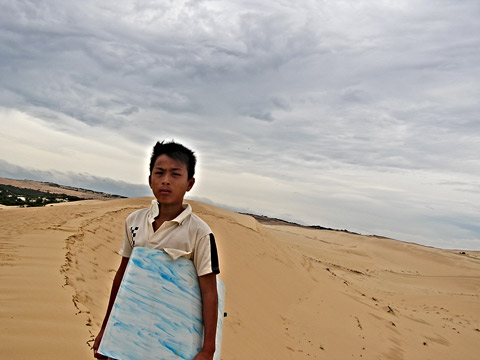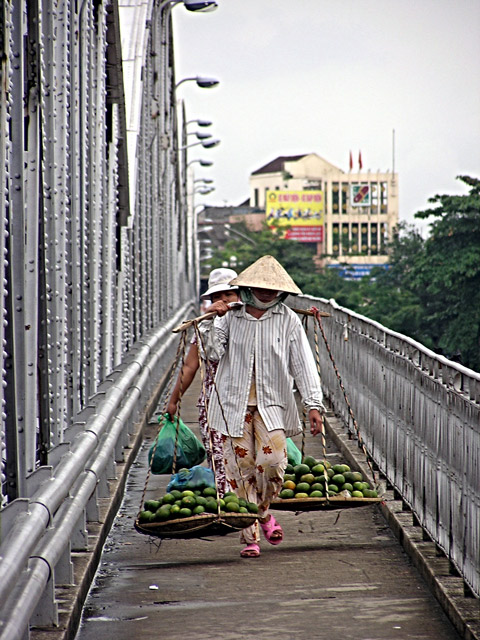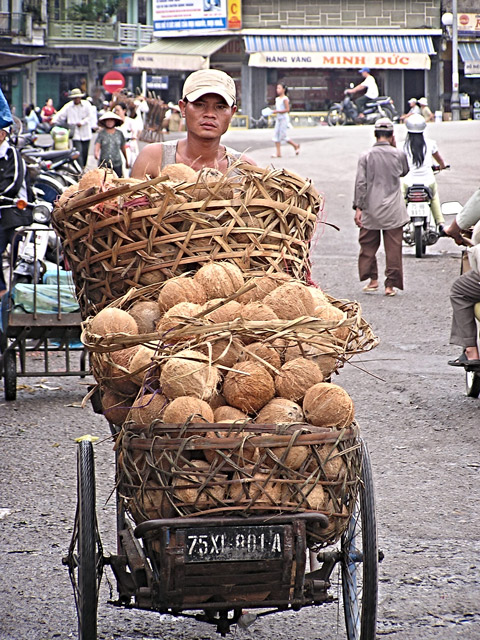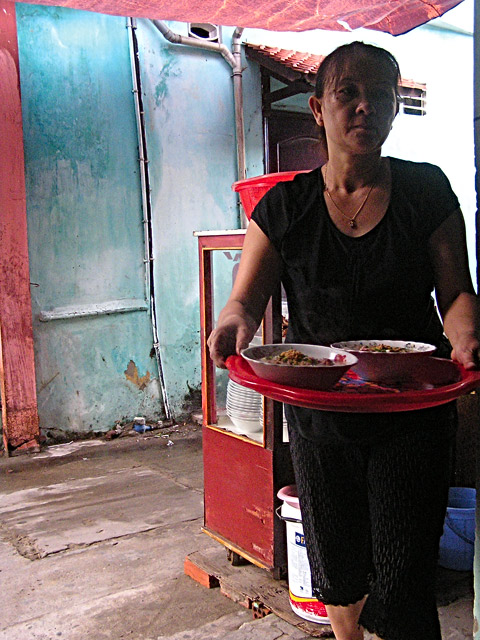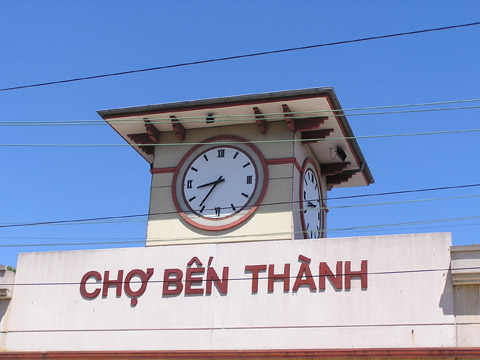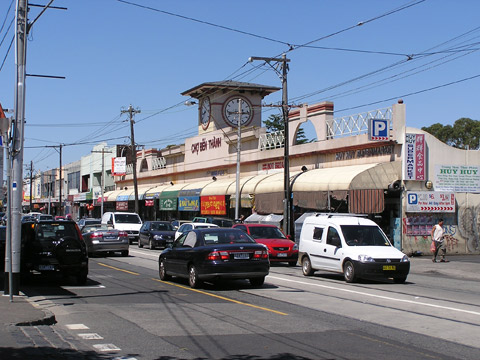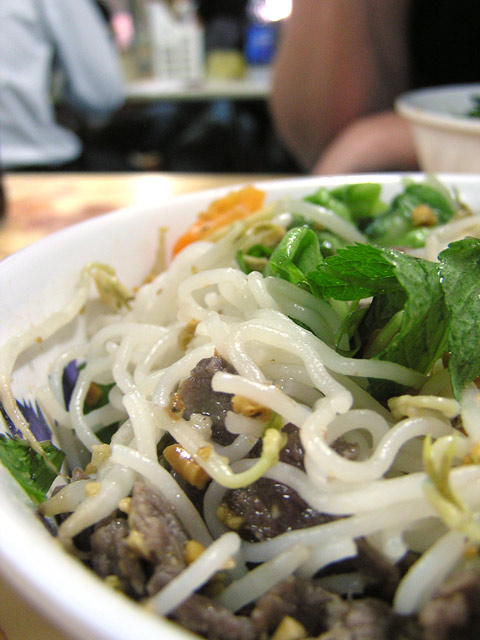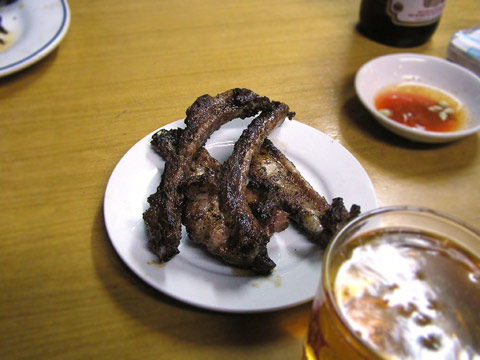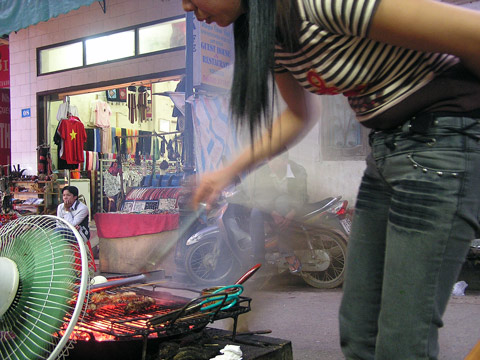Originally sent: 10 October 2005
Pchum Ben, a holiday to appease the spirits of the dead, happened last week. Most Cambodians leave Phnom Penh to give offerings of food at their local pagoda to ensure that their deceased relatives don’t return from the grave to stalk the earth as a hungry legion of the Undead. I’ve been told that there is a type of ghost that can take possession of you while you sleep and detach your head and innards from your body, and then float about using your entrails to consume unsuspecting victims and livestock. Pagoda offerings apparently sate their bloodlust for the year.
The good news for non-believers is that firstly I get 3 consecutive public holidays, so could get a boat down the Mekong to Vietnam to avoid the local undead; secondly that the Buddhist monks get to eat their fill of the offerings and then bring the leftovers to work for me. On a good day, I get banana-leaf packages of sticky rice that surrounds a delicious banana/bean filling and on a bad day, I get banana-leaf packages of sticky rice that surrounds a fatal raw fish/salmonella filling. Both are identical from the outside and their true nature is hidden by the odor-masking properties of banana leaf. Picking the wrong one feels like your stomach has been taken on a entrail-detachment joyride by a poltergeist.
Partly due to the expense of flying anywhere, we decided to sail to Ho Chi Minh City. For $20 we were promised a bus then boat straight into the Mekong Delta bird-flu territory, a night’s accommodation, tours, then a bus to Ho Chi Minh City. My workmates thought that for that price we were being sold into slavery. We were also promised that we could get our Vietnamese visa in 24 hours which I still can’t believe happened.
The boat to Vietnam was fairly uneventful. Kha Orm Nor at the Cambodian border has the silliest border post I’ve seen, insofar as it is the only one I’ve seen with an Olympic-quality badminton court. When the boat arrived there, M thought that we were stopping at a riverside resort for lunch; the Cambodian immigration guys had a level of joviality that could have only been brought on by an excessive amount of either badminton or extortion. They laughed so hard when I spoke some Khmer to them that they didn’t even bother looking at my passport before stamping me out of Cambodia. Just down river, the town of Chau Doc is the preferred launching port for petrol smuggling into Cambodia and so the border guards must be getting their fair piece of the action. Vietnam subsidises their fuel, Cambodia doesn’t, and so a canny Khmer smuggler can make as much as $1 a day in arbitrage depending on how quickly they can row.
Chau Doc has all the ambiance of a 15th century smuggling port and thankfully we were only staying for a night and far enough from town to not be conscripted into a life of river piracy. Near the hotel was Sam Mountain, which was predictably spruced up with shrines to practically every faith; unpredictably it was covered with giant concrete dinosaurs and mermaids, possibly presaging a return to animism for Vietnam. The next morning, we got our dose of authenticity by having someone canoe us about the Mekong so that we could point our cameras at unwary floating fish farms, pagodas, and the local Cham Muslim people.
Apart from doing the sights of old Saigon, the real highlight of getting to Ho Chi Minh City was eating vast quantities of Vietnamese food which we could then wash down with the local coffee. One of the weirdest things I’ve been missing from Melbourne is Vietnamese noodle soup (pho) from Mekong Restaurant on Swanston Street; a desire made even stranger because there is a Vietnamese restaurant about 5 minutes away from our house in Phnom Penh to which I have never been. As an indicator of how much we ate, the only piece of Vietnamese language I learnt was “pho” which is actually pronounced more like “fur” than “poe”. I also make guest appearances as the wanker that orders in French. Very little of the pho lived up to Mekong’s extremely high standard, even though most of our two days in HCMC was spent wandering about trying literally every restaurant and cafe we saw.
The only place we actively sought out was a restaurant that specialised in barbecue that one writer has described as “filthy top-shelf meatporn“. Animal genitalia was a dining option, along with the usual array of rodents, reptiles, arachnids, and Bo Tung Xeo after which the restaurant is named: marinated beef chunks that you lightly sear on your own white-hot table top barbecue. After inspection of the live snakes, we opted for the beef with a side serve of goat flesh. It was so juicy and tender that my next purchase in Phnom Penh will be deworming tablets.
M judged our bus ride home as the worst that she has ever been on, and she’s been on a bus ride on the road that is legendary as the worst in the world (La Paz to Rurrenabaque, Bolivia). The last 60km from Neak Luong to Phnom Penh took about ten hours to cover, seven of which were spent queuing for a ferry. We would have been slightly better off swimming the river, buying an ox cart to drive us home and then barbecuing our means of transport as a Pchum Ben sacrifice. The bus was made all the more excruciating because the travel agent we’d booked through in Vietnam lied and didn’t book us seats, so we got one seat and one plastic chair in the aisle. M managed to strongarm her way into a seat when the previous occupant got up to have a vomit. It got that nasty.
Other than our weekend travels, I’ve been doing feelgood, humanitarian work that you see in UNICEF think-of-the-starving-children brochures: distributing schoolbooks to children with AIDS. It is more depressing than rewarding as many of the kids or their families will be dead before the school year ends, although I did get a superb moment of ecumenical irony when I realised that we were using Buddhist monks to distribute cash from a gay Christian church to Muslim school children. It is annoying that it is so easy to find money for these sort of projects rather than finding money to pay our accountant a decent salary, so that more of these sort of projects are possible in the first place.
Addendum: 2012
After I sent this group email, a few of my friends emailed me back to say that I should publish them because they had started forwarding them on to their friends.
I’d been kicking around the idea of starting a food blog for a few months but after their emails I registered the URL phnomenon.com, named after the subject line of the first group email that I sent.
